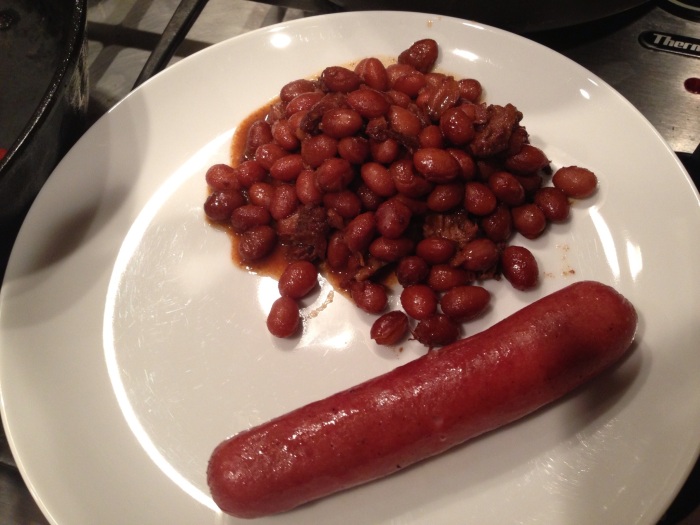Posts Tagged ‘Rosemont Market’
Pork, Pork and More Pork (Plus Recipes)

Butcher case at Rosemont Market’s Brighton Avenue location, where local lard is touted as the new olive oil. Pork there is from Milkweed Farm right here in Brunswick.
I’m totally spent, after appearing on local TV for the first time, and banging out a cover story for The Portland Phoenix’s pig issue, plus my side column take on Jews and pork. I attended a whole hog butchery workshop (lung was delicious, spleen was gross) and have tracked down numerous chefs, pig farmers and butchers. I remain indebted to Oregon for teaching me how to cure my own guanciale and to seek out meat CSAs and heritage Red Wattle hogs. Now, for some recipes (previously discussed on our latest WBOR radio show on food waste).

Breaking down half a hog in the butchery and curing workshop organized by Giant’s Belly Farm in Greene, Resilient Roots and the Local Sprouts Cooperative.
First, pig ears, normally considered dog food/dog chew toy. Perhaps they should stay that way. I’m all for crispy pig ears at restaurants, but I found them a bit gross and not worth the effort to do at home. I worried about ear wax and hating shaving the ears of hair. For a recipe, I consulted the trusted Michael Ruhlman, a charcuterie guru with a new book out (with co-author chef Brian Polcyn, whom I interviewed) on the porky art of Italian dry-cured Salumi. He recommended prepping pig ears confit-style.
So I rubbed the ears with salt, pepper, garlic and Chinese five spice powder and let them cure overnight (well, ok, they were left in the fridge for a few nights). I was thinking crispy pig ear banh mi. That never happened. I confited them in a super-low oven in grapeseed oil (didn’t have lard). But when I tried to fry them up, they were chewy and gummy and not that crisp. I now see I ignored Ruhlman’s advice to roast them, weighed down between pieces of parchment in a 425 to 450˚ oven. My bad. I missed his note that “a serious issue with frying is that water remaining in the skin can cause them to pop and splatter in hot fat.” Splatter they did.
The pork roast, really an uncured bone-in ham, recipe I tried from Tamar Adler‘s An Everlasting Meal: Cooking with Economy and Grace proved far more satisfying. I got to taste a little roasted bone marrow, which tasted just like that fancy restaurant appetizer. The next day, I made a good ole New England pot of baked beans, flavored with the bone and pork scraps, inspired by a recipe in a recipe from the revamped classic Cooking Down East. Here’s Adler’s recipe…you definitely want to try to brine the ham first, to tenderize the dense muscle. I added molasses and liquid smoke to the brine, to make the meat, well, more ham-like.

The lovely bone-in ham roast (see that yummy bit of marrow) from a Red Wattle hog from Squire Tarbox Farm on Westport Island.
Meat brine (from Tamar Adler’s An Everlasting Meal; roast follows)
1/4 cup salt
1/2 tablespoon sugar (I used molasses too)
water
2 bay leaves
2 whole dried chiles
1 teaspoon juniper berries
4 sprigs thyme
1 teaspoon peppercorns
Combine the salt and sugar over low heat with 1/4 cup water. As soon as the salt and sugar have dissolved, take it off the heat. In the container in which you’re going to brine the pork leg roast, combine everything with a few ice cubes. Mix it all well. Once it is cool, add the meat and water to cover. Brine, before meat is added, stays good forever.
Pork roast
Brine a three-pound pork leg roast (preferably bone-in for flavor) overnight in the refrigerator. Cover the meat with a plate that fits inside the container and weigh it down so that it doesn’t float. Heat the oven to 375 degrees. Remove the pork from the brine and pat it dry. Heat a cast-iron pan or heavy-bottomed pot over medium heat and add 1 tablespoon olive oil. Brown each side of the meat over medium-high heat. Let each side turn caramel brown. This will take 10 to 15 minutes.
Once the pork is browned, put the pan or pot directly in the oven. Cook the meat, untouched, until it’s medium-rare. In an oven, this will take about 20 minutes per pound. Pork will need an internal temperature of 165 degrees when you pull it out of the oven, and will go on cooking once you remove it. Err on the side of under-cooking the meat. Check it with a meat thermometer at its thickest part until you get good at telling doneness by pressing on the meat.
Remove the meat from the pan and let it sit on a cutting board. It needs to rest for at least 20 minutes. Sliced earlier, the outside of the pork may taste salty; if there is still a bone in the cut, the meat along it will still be bloody.
Slice the meat thinly with a sharp knife. If you can avoid it, leave the serrated knife for bread and use the sharpest straight blade you have.
Serve with a big green salad.

Hog butchery workshop in South Portland (notice James Beard Award winning chef Rob Evans of Duckfat in the audience!)


